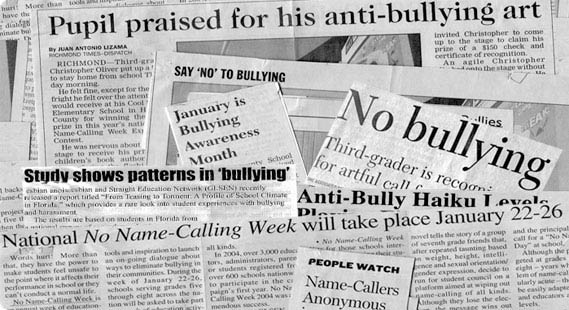The
Power of Words
Bpenn005. (July 6 2009). Bullies. Retrieved from: https://commons.wikimedia.org/wiki/File:Bullies.jpg
This
week we explored the writing strand of the Ontario Curriculum for Language
Grades 1-8. Our task this week was to explore resources through social media
networks such as twitter and Pinterest. While exploring Pinterest, I found a
few resources that are useful to teach students tips about writing. However, I
felt it was important to not only teach students how to write, and how to write
well, but to also teach students the power of words. Therefore, it made me
contemplate on what sources would reveal this. I turned to Twitter, a network
that I do not utilize; though found it useful for this topic. I decided that a
great topic to search would be “#cyberbullying”. Nowadays, majority of schools,
if not all schools, enforce the policy of zero tolerance. Therefore, you could
utilize this source in two ways. You could teach students the power of words,
while also teaching them about bullying and the different formats of bullying.
The
main thing I want to focus on is the power of words. Learning how to write is a
right that everyone should have. However, you never have the right to use this
skill to harm another person. Rather than using words to hurt someone, students
can learn how to send positive messages through words.
Retrieved
from: https://pixabay.com/en/cyber-bullying-bully-rumor-teasing-122156/
The writing strand of the Ontario Curriculum of
language grades 1-8 states:
The
more students read and write, the more likely they will be to develop an
essential understanding of the power of the written word. (12)
This enforces what I have been saying above. It is a
great skill to be able to write, and to write well. However, students sometimes
forget or choose to ignore the damage that can be caused due to your choice of
words. The links provides you with additional tools to help enforce this
message. This is enforced through the URL link through external links, videos
and pictures.
This is useful in the
classroom because it is working towards ending bullying, and ending the use of
words in negative connotations. Teachers can have students create positive
messages in literacy class or in art class, to post around the classroom walls.
Encouraging words and quotes can be used to teach students the power that these
words have. Maybe if students see the effect that positive words have on them,
they will think twice before using negative words and messages.
Kiran Foster. (October 1 2012). Self-esteem. Retrieved
from: https://www.flickr.com/photos/rueful/8065467654
Using this skill to
send positive messages is beneficial for all students to master because it can
really change the dynamic of the classroom, and the learning experience of all students.
Therefore, the educational benefits of this resource are to help create a safe
learning environment because this goes beyond the classroom. If something is
happening online outside of the school, the students bring that energy into the
classroom with them because they will fear the possibilities that could happen
in the classroom. Students can view this resource and see for themselves the
effects their words can have on others. That being said, students can learn
that even though writing is a right everyone should have, you should not abuse
that right at someone else’s expense.



No comments:
Post a Comment